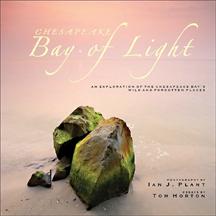|
|
|
||||||||||
|
|||||||||||
|
|||||||||||
The Chesapeake: Our Fleeting WildernessTom Horton and Ian Plant give our Bay a fresh look for the new yearreviewed by Carrie Madren
Boats, bridges and buildings crowd the Chesapeake Bay that most of us know. But Tom Horton and photographer Ian Plant show us a pure and wild Chesapeake — like the one John Smith encountered in 1602 — in Chesapeake Bay of Light, their new 192-page coffee table book. At a generous 12 by 12 inches, this hardback tome shows us parts of the Bay still unspoiled by human touch. Horton writes with new hope. For example, the John Smith National Historic Trail could be a turning point — “a powerful ‘hook’ for those lobbying to protect other parts of the watershed,” he writes in the introduction. Can seeing our old Bay in their new light revive our hope in this new year? An Idea Brought to Light“The idea came to me about three or four years ago as I was working on a book in Virginia and absolutely fell in love with luminous qualities of the Bay,” Plant told Bay Weekly. Plant then sought the writer to add the illumination of words. “I read about Tom doing a kayak trip through his posting on the Chesapeake Bay Foundation website,” Plant said. “And I thought, that’s the guy I want to write for the book.” Horton wasn’t an easy sell. “I was a little resistant at first because I had written for other photo books,” Horton said. “But I looked at what he was doing photographically; his pictures are so elemental.” With photos of expansive marshlands, mudflats and wildlife, Horton concluded “I could write about pretty much whatever I wanted; the words didn’t have to illustrate a particular thing” — like skipjacks, blue crabs or watermen. Freedom suited Horton, a former Baltimore Sun columnist. “I like to write about rhythms of the tide, rhythms, cycles and play of the light around the edges of the Bay; getting at the essential bones of what the Bay is,” he says. “A few of these essays I’d been wanting to write for years, but they didn’t fit into a newspaper column.” Into the WildPlant’s voyage, he writes in his Artist’s Statement, “has been a search for the Bay’s remaining pockets of wilderness, and a search for the wilderness within.” Wilderness, Plant says, is “an area where you see nothing but nature; no signs of civilization.” Embarking on a 17-foot sea kayak, Plant opens a “window to the world that Captain John Smith might have seen; largely untouched by the hand of man,” he says. Finding those purely wild spaces took some doing. “I was required to get off the beaten path,” Plant says. “Sometimes I traveled to undeveloped islands.” The longest water crossing was eight miles, he reports, and some kayak trips covered 20 to 30 miles a day. Much of the wilderness turned up north of Baltimore, near Aberdeen Proving Ground. The military used its waterfront land as a security buffer, so much of it was preserved. Plant also found views around Calvert Cliffs State Park, preserved parkland along the Potomac River, shorelines and parks in Virginia’s rivers and along the Eastern Shore. Over three years, Plant hiked and paddled with his digital camera to shoot “far more than I’m willing to admit.” “Past photo books on the Bay tended to focus on human life; this is the first book that focused on wild spaces,” Plant says. Thus you won’t see a single person, boat or building here.
Telling the Bay’s StoryHorton accompanied Plant on several daytrips, with many more kayak jaunts on his own, always with a reporter’s notebook and a pencil. Ballpoint pens, he says, won’t write when the weather turns chill. Quickly captured ideas and observations turned into colorful, appealing essays on Bay cycles and life, including blue crabs, pelicans and bald eagles. He meditates on how human lives intertwine with ecology, weaving in experience and knowledge. Horton also chronicles the plight of the Bay and our largely unsuccessful efforts to recover our losses. The future is uncertain, but he remains hopeful. “Maybe you could think the status quo, holding the line, was not so bad,” Horton muses in the Afterword, “and that continuing to strive for ‘restoration,’ like world peace and justice for all, is a worthy goal that, even though we’re bound to fall short, will at least keep us pointed in the right direction.” Like the Bay’s edge, each page brings an unanticipated image or idea. It’s a good book to accompany you into 2008. Chesapeake Bay of Light: $45 from www.mountaintrailpress.com. |
|||||||||||
|
|||||||||||
|
|
|||||||||||
|
© COPYRIGHT 2008 by New Bay Enterprises, Inc. All rights reserved. |
|||||||||||


